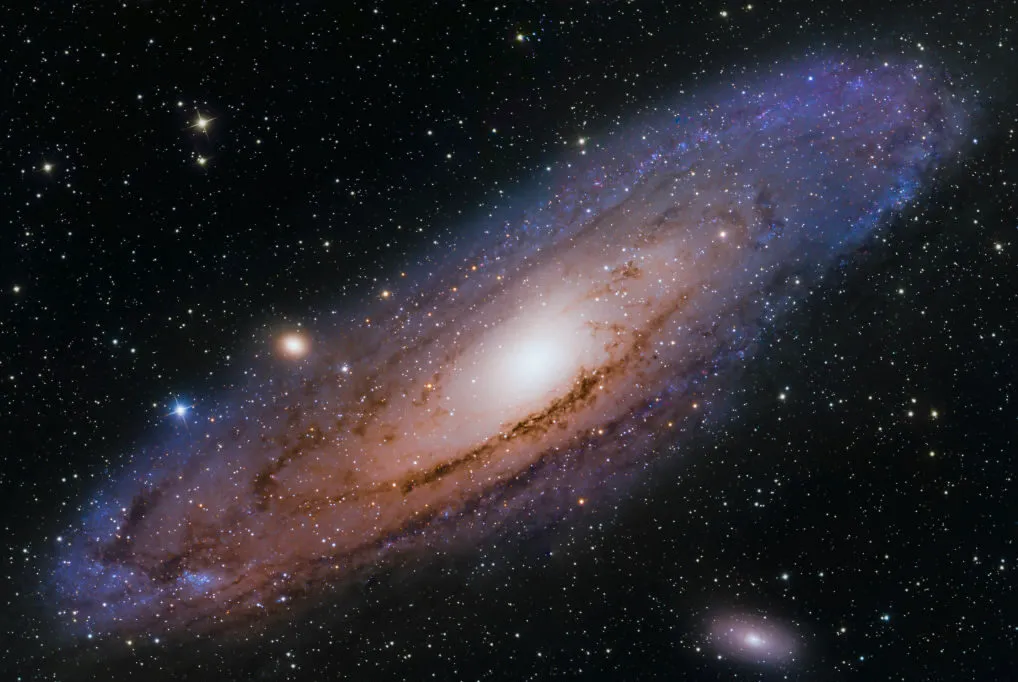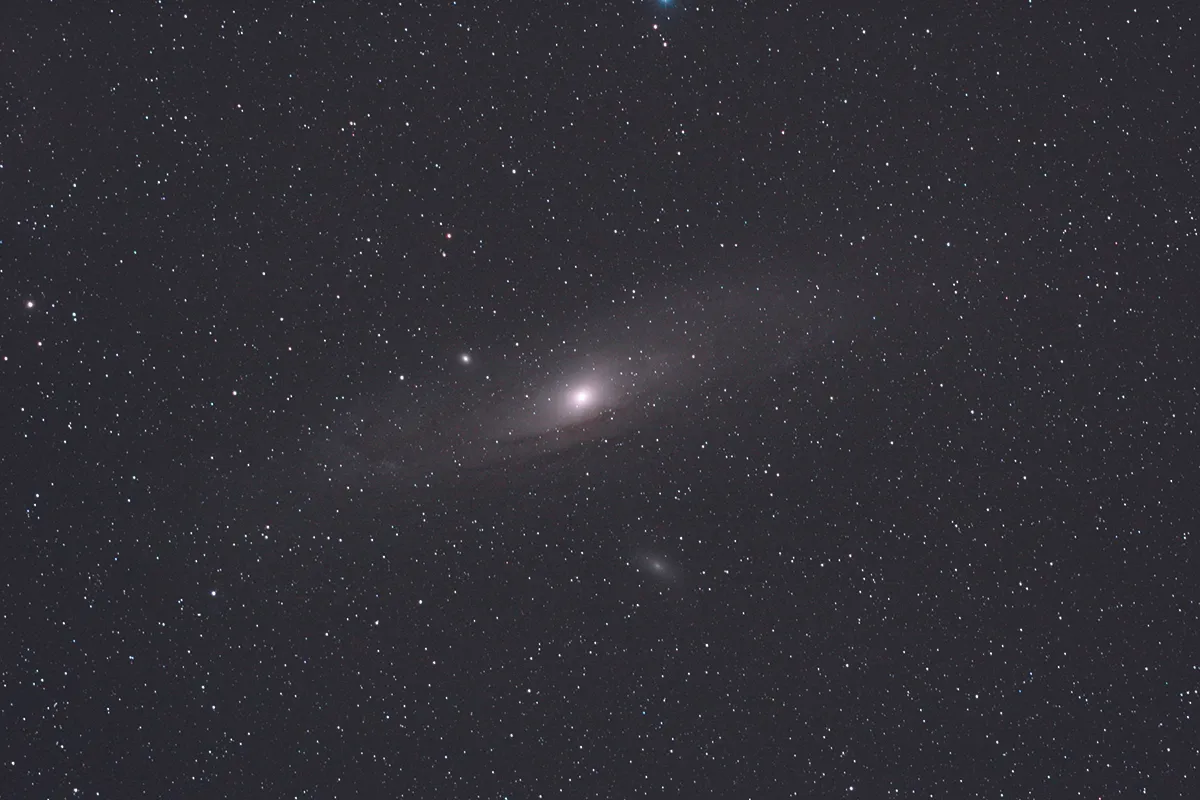You can see the Andromeda Galaxy best in autumn, at its highest in the south around 8pm, but it is visible from the northern hemisphere throughout much of the year.
A a large bright spiral galaxy located 7.7° northwest of star Mirach, the Andromeda Galaxy is the only major galaxy you can see without optical aids.
Under dark, Moon-free skies, your unaided eye should be able to find the Andromeda Galaxy as a faint misty patch a short distance from the band of the Milky Way.

The ancient Persians called it a ‘little cloud’ and it was key to the the arguments put forward during astronomy's Great Debate of 1920.
From urban locations, the galaxy is equally visible in binoculars, even if you have a fair amount of light pollution. But dark, moonless skies will give you the best views.
The Andromeda Galaxy is the furthest object you can see without any optical aid, although conditions must be good in order to do so.
Did you know that the Andromeda Galaxy is set to collide with our own Milky Way galaxy in the distant future? It's known as the Andromeda-Milky Way collision.

Using binoculars, you’ll find and see the Andromeda Galaxy with little or no difficulty. It will be oval in appearance – although you won’t be able to make out any of the individual stars within it.
The Andromeda Galaxy looks great through smaller telescope of, say, 4 inches in diameter. The galaxy appears as a larger, elongated oval shape with a core that shows up as a slightly brighter area.
A small telescope scope reveals that the famous elongated glow is just the core of the galaxy, an ellipse approximately 30x10 arcminutes in size.
The fainter spiral arms sit outside the core. A low power shows the galaxy off best.
How to find the Andromeda Galaxy

Find the Andromeda Galaxy in the night sky by beginning at the Great Square of Pegasus.
Imagine a diagonal from the southwest to northeast corner (lower-right to upper-left as seen from the UK), and extend it for about the same distance again to reach mag. +2.1 star Mirach (Beta (b) Andromedae).
Turn by 90º to head northwest for a short distance towards dimmer mag. +3.9 Mu (m) Andromedae and then dimmer still mag. +4.5 Nu (n) Andromedae.

You can also use star Schedar in the W-shaped constellation Cassiopeia to find the Andromeda Galaxy.
Schedar sits at the bottom of the 'deepest' of the two Vs making up Cassiopeia's W shape.
Imagine that V is an arrow. It points almost directly at the Andromeda Galaxy.
You can find another good method for locating the Andromeda Galaxy in our star-hops to help you navigate the night sky.
How far away is the Andromeda Galaxy?

The Andromeda Galaxy is a staggering 23 billion billion km away. Using more standard large-scale space units, it’s around 2.5 million lightyears away.
In other words, you’re looking at the galaxy as it was 2.5 million years ago.
When you consider that most of the stars we see are just tens or hundreds of lightyears away, the distance to the Andromeda Galaxy becomes phenomenal.
This is about the farthest thing in the Universe that you can see using just your eyes.
Another amazing aspect becomes apparent when you photograph the Andromeda Galaxy: its enormous extent in the sky, spanning then width of six full Moons side-by-side.

Found the Andromeda Galaxy? Now tour it with your telecope
Take our tour of the Andromeda Galaxy below with your telescope and discover its most intriguing sights.
These targets can be seen with a refractor under 4 inches or a reflector/SCT under 6 inches.
With bigger telescopes, you’ll see a galaxy with spiral arms that’s similar to the Milky Way.
The Andromeda Galaxy and our own are the two most massive systems in a Local Group of around 30 galaxies.
But while our Galaxy has up to 400 billion stars, Andromeda is thought to contain a trillion.
With so many more stars, it could mean that there’s more chance of life existing over there, in our similar but larger galactic sibling.
If you'd like to take a closer look at the Andromeda Galaxy with your telescope, take our deep-sky tour below.
Download a PDF guide to help you take the Andromeda tour.
6 sights to see in the Andromeda Galaxy with a telescope
M31

Start your journey into M31 by looking for the dark dust lane that runs along the northwest edge of the core. Look for the faint glow of the spiral arms beyond this lane.
This glow continues toward another dark lane located further out. Notice also how the central region fades inwards towards a star-like core
M32

Observe how far M31’s core extends from the galaxy’s centre. One measure for this is satellite galaxy M32 which sits 24 arcminutes south of M31’s star-like core.
This mag. +8.1 elliptical appears like a large fuzzy star at low powers. M31’s elliptical core should extend, along its main axis beyond M32. If it reaches the 7th magnitude star HIP 3293, 13 arcminutes southwest of M32, you’re doing well.
M32 itself appears non-circular, an oval glow measuring 3x2 arcminutes. Like M31, the core of M32 appears almost stellar in nature, but larger apertures will reveal it as an extended region about 10-15 arcseconds across. M32 is an elliptical dwarf galaxy with a mass equal to around 3 billion Suns.
M110
Like M32, M110 is another gravitationally bound satellite galaxy of M32 and another elliptical galaxy. It appears fainter and more elongated than M32, M32 being classed as type E2 while M110 is type E6p. M110 sits 35 arcminutes northwest of the centre of M31, 1.5x the apparent distance of M32 from the centre of M31’s core.
The surface brightness of this mag. +8.5 galaxy is lower than M32’s and it can be lost due to light pollution. It has an apparent size about 10x3 arcminutes, appearing like a north-south aligned streak.
NGC 206

We return to the main galaxy for our next object, NGC 206, a bright star cloud. When observing the Andromeda Galaxy through a scope, it is obvious that the main galaxy is dominated by its bright core.
And it takes patience to see anything other than the core. The dark dust lanes mentioned previously are obvious candidates but there are other parts of the galaxy to see.
The trick to finding NGC 206 is to use the obvious visible components – the centre of M31 and M32. The star cloud lies at one vertex of a squat isosceles triangle formed using M32 and M31’s star-like core, M32 being the apex of the triangle. NGC 206 is truly a part of M31.
NGC 185

M32 and M110 are often cited as M31’s satellite galaxies, but they’re not the only ones. NGC 185 is another example. To see it you’ll need to move into Cassiopeia and head 7° north of M31 to arrive at mag. +4.5 Omicron (ο) Cassiopeiae. Mag. +9.2 NGC 185 sits 1° to Omicron’s west.
This lesser-known satellite of M31 is a moderately bright dwarf spheroidal galaxy. A 150mm scope will reveal it as about 4 arcminutes across, a bit elongated in an east-west direction. It appears 25% larger in a 250mm scope, with a more circular appearance
NGC 147

NGC 147, is a tricky object, even with large instruments. Head west from NGC 185 for 1°, nudging a little north. This is another dwarf spheroidal galaxy and another M31 satellite.
A 300mm instrument will show it as a faint smudge, 3x2 arcminutes in size, appearing to brighten as you head into the centre towards a stellar nucleus. Like M31, it’s around 2.5 million lightyears from us.
This guide originally appeared in the December 2019 issue of BBC Sky at Night Magazine.

